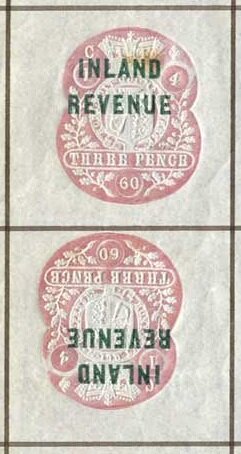Tete-Beche: Embossed design (United Kingdom of Great Britain & Northern Ireland 1860)
Embossed design (United Kingdom of Great Britain & Northern Ireland 1860)
03 April (United Kingdom of Great Britain & Northern Ireland ) within release Inland Revenue goes into circulation Tete-Beche Embossed design face value 2*3 British penny (old)
| Tete-Beche Embossed design in catalogues | |
|---|---|
| Stanley Gibbons: | Sg: GB F29a |
Tete-Beche is square format.
Thick "INLAND REVENUE" underprint, design incorporates date tablets dated between March and April 1860 Die C Authorised for postal use from 1 January 1883Also in the issue Inland Revenue:
- Stamp - Embossed design face value 3;
- Tete-Beche - Embossed design face value 2*3;
- Stamp - Embossed design face value 3;
- Stamp - Embossed design face value 6;
- Stamp - Embossed design face value 6;
- Tete-Beche - Embossed design face value 2*6;
- Stamp - Queen Victoria face value 1;
Tete-Beche Embossed design it reflects the thematic directions:
A coat of arms is an heraldic visual design on an escutcheon (i.e. shield), surcoat, or tabard. The coat of arms on an escutcheon forms the central element of the full heraldic achievement which in its whole consists of shield, supporters, crest, and motto. A coat of arms is traditionally unique to an individual person, family (except in the United Kingdom), state, organisation or corporation.
In British heraldry, a coronet is any crown whose bearer is less than sovereign or royal in rank, irrespective of the crown's appearance. In other languages, this distinction is not made, and usually the same word for crown is used irrespective of rank (German: Krone, Dutch: Kroon, Swedish: Krona, French: Couronne, etc.) In this use, the English coronet is a purely technical term for all heraldic images of crowns not used by a sovereign, and implies nothing about the actual shape of the crown depicted. A Coronet is another type of crown, but is reserved for the lower ranks of nobility like Marquesses and Marchionesses, Earls and Countesses, Barons and Baronesses, and some Lords and Ladies. The specific design and attributes of the crown or coronet signifies the hierarchy and ranking of its owner.


